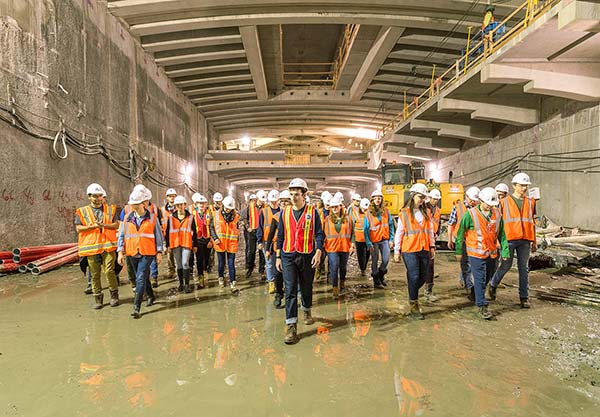Grand Central Terminal
At the entrance to Grand Central Terminal on 42nd and Park Avenue, sitting atop Cornelius Vanderbilt’s “temple to transportation,” a trio of statues represent Mercury, Hercules and Minerva — the Greek gods of speed, strength and intellect.
The beauty of the main concourse, with its imposing pillars, infamous vaulted gold-leaf painted ceiling and arched windows welcomes 750,000 busy travelers, commuters and visitors each day.
Jacqueline Kennedy called it “a universal symbol between New York’s past and present,” but underneath the grandeur of the terminal Sebastien Alvarado and CJ Klein are among those getting a glimpse into the future. “You walk around Grand Central Terminal and then round a corner and there’s a plywood door, and you descend down into a whole other space,” says Diane Westerink.

The Manhattan Transit Authority’s East Side Access Project (ESA), sits 160 feet under Grand Central Terminal and is an example of the kind of complex planning and organization that goes into developing transportation infrastructure.
Here, engineers are building a new eight-track terminal and concourse to service the Long Island Rail Road — and connect an estimated 162,000 people to Manhattan coming from Long Island and Queens.
“You have the enormously, densely populated city above you. How do you make this all work? That’s where you dig like a mole with the aid of the newest and best technologies available.” – Joannes Westerink
“Look at all the millions of people coming in and out of Manhattan every day,” Joannes Westerink says. “How do you manage that? If you just had roads that did that, it would be impossible. There’s no way you can have a place like Manhattan without efficient rail-based transport. This is all about transportation systems. What does it take to get the logistics to work out? How do you improve the efficiency of the system and where you’re moving people and where they can go?”
This train station beneath a train station is a massive construction site for the senses. The scale of the caverns dwarfs the workers. Wearing steel-toe boots, the students step across muddy floors. Artificial light illuminates dramatic arches and the air smells of concrete. The tunneled rock is largely finished, the escalator and elevator structures already in place.
“I was amazed by the strategic planning and the organization of the project at each stage,” Alvarado says. “I was able to recognize how schedule planning and work ethic are the main keys for success for such a big scale project.”
The ESA project began with conversations in the 1950s. It is expected to be complete in late 2022. The $10 billion project includes eight miles of new tunneling.
“It was — and still is — hard to contemplate that I was more than a hundred feet underground, under the largest city in the U.S.,” says Klein. “The sheer size of the tunnels was enough to leave me nearly speechless.”